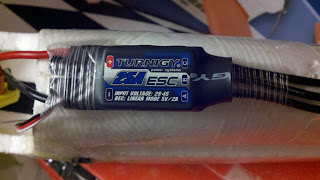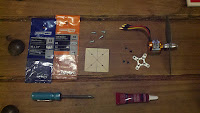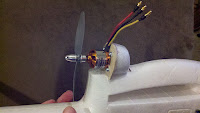 |
| The 3 blade prop was just for testing |
 Now on to the speed controller. I was looking for a controller that would handle 15 to 18Amps, but again, the one I really wanted was not available (back ordered), so I found this one for more money, but from the description and people's reports this one can easily handle long bursts to 40Amps. It is programmable with an inexpensive programming card but can also have basic programming done with your transmitter throttle settings. It is a little bigger than I expected, but oh well, I have it and it works very well and I don't think I will have to worry overloading it.
Now on to the speed controller. I was looking for a controller that would handle 15 to 18Amps, but again, the one I really wanted was not available (back ordered), so I found this one for more money, but from the description and people's reports this one can easily handle long bursts to 40Amps. It is programmable with an inexpensive programming card but can also have basic programming done with your transmitter throttle settings. It is a little bigger than I expected, but oh well, I have it and it works very well and I don't think I will have to worry overloading it.Finally the battery. I was going to just use the batteries that I made from laptop batteries, but decided that they were just too inexpensive to pass up. I found this (again) Turnigy 2200mah 3C 11.1V pack. It was listed with a discharge range (20 to 30C), which seems a little unusual, but it was easily above what I expected I would use. 20C times 2200mah means that it could supply at least a maximum discharge rate of 44 amps. See, plenty of performance for this setup.
The nice thing about having everything Turnigy is that all the connectors fit without any trouble or issue.
Now the new mod is a mod to keep my "high tech" camera mount from damaging the wing again.
 In these two pictures you can see the damage that occurred to the trailing edge and how the tape cut into the wing under the force of the weight of the cell phone. Of course, this would not have happened had I been able to learn how to land properly. But, I have not, and I'm not sure when I will.
In these two pictures you can see the damage that occurred to the trailing edge and how the tape cut into the wing under the force of the weight of the cell phone. Of course, this would not have happened had I been able to learn how to land properly. But, I have not, and I'm not sure when I will.OK, before I get to much further into this, I guess I should tell you about some background on my method of this repair/mod. So, some months ago, when I first got going into repairing my Wild Hawk and using tooth picks, foam chunks, and hot glue, I introduced my Dad to this. He started to kind of take off with the idea of using cheep and free items to use for repairs. My Dad told me about how he was collecting free coffee stir sticks to add to his supplies. Now, I'm from a 100% Dutch family and predominately Dutch community and I am no stranger to the tendencies of the Dutch to be, shall we say, penny pinchers. But my Dad collecting wooden coffee stir sticks struck even me as going a bit far and was something that I was not going to do, especially since I could get all I wanted from my work for free. Well, now I'm looking at the issues with my wing repair and reinforcement and what comes to my mind as being the perfect item to assist with my repair? You guessed it, a wooden coffee stir stick! Did I have any in my supplies to assist with this repair? No, of course not! I'm sure my Dad had many available and could have fixed this issue on many wings, but not me. I was not
Well, after scowering my wife's endless craft supplies I had to settle for a tongue depressor. If I couldn't find a wooden coffee stir stick, a wooden Popsicle stick would have been a good second choice. Well, we did not have any of those either. So, a wooden tongue depressor was what I was going to have to work with.
OK, on with the repair. I molded the foam back into place and started looking at how the wooden tongue depressor would be used to re-enforce the location. I used my Exacto saw and started cutting the depressor down to size.



Soon I had a piece that I was happy enough with and was ready to hot glue it into place.
Now I strapped the phone into place to check things out. You can see how the phone looks on the bottom side of the wing with the strapping tape holding it in place. The photo to the right and below shows the top side of the wing with the trailing edge re-enforcement and how the strapping tape wraps around and is prevented from doing more damage.
Now I'm waiting for my free time to align with good weather to try this out and see if it really works as expected.
Thanks for stopping by my blog and please post comments, good or bad. Be sure to come back and check for future posts.





























